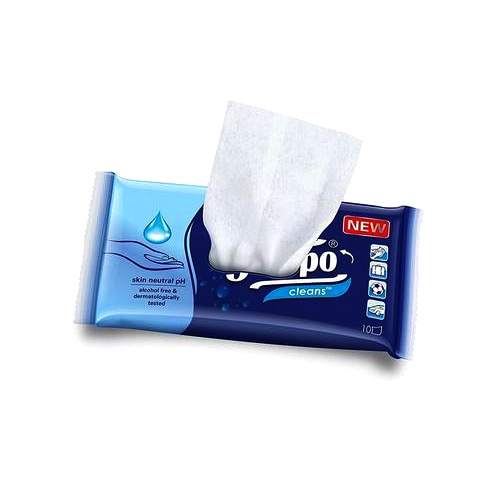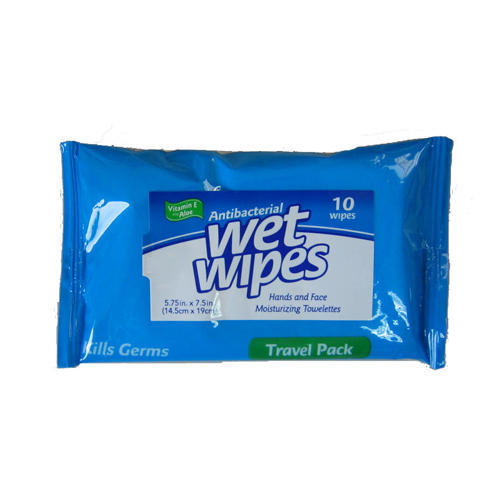During epidemic, many kinds of wipes appear on the market in large scale. Common ones are ordinary wipes, sanitary wipes and disinfection wipes. However, you might have the same questions with me. How do they differ from each other? Can sanitary wipes replace disinfection wipes? How to define disinfection wipes?
1. Wipe classification, function and application
1) Ordinary wipes
a. Definition: the wipes cleaning hands, skin mucosa, or object surface. Their carriers can be non-woven, fabric, airlaid paper or other raw materials. Besides, purified water and proper excipients, such as preservative, are used.
b. Function: for cleaning
c. Application: to clean hands, skin mucosa, or object surface.

2) Sanitary wipes
a. Definition: the wipes using non-woven, fabric, wood pulp composite cloth, or wood pulp paper as carrier, proper production water and disinfectant, to clean and sterilize hands, skin, mucosa or object surface.
b. Function: cleaning and sterilizing.
c. Application: hands, skin, mucosa or object surface.
3) Disinfection wipes
a. Definition: wipes using non-woven, fabric, airlaid paper or other material as carrier, purified water as production water and proper preservative as excipients; to clean and disinfect human body, normal object surface, medical instrument surface...
b. Function: cleaning and disinfecting.
c. Application: human body, normal object surface, medical instrument surface; more commonly used to disinfect medical instruments.
d. Using principle: cleaning and disinfecting when there is no obvious contamination on objects.
However, what do cleaning, sterilizing and disinfecting mean?
A. Cleaning: to remove organic matters, inorganic matter and obvious contamination;
B. Disinfecting: to remove or kill pathogenic microorganisms on objects;
C. Sterilizing: to kill all microorganisms on medical instruments or other objects.

2. Technical index
1) Ordinary wipes
a. Microbiological index: total number of bacterial colonies cannot be more than 200CFU/g; no checking-out of E. coli colony; no checking-out of pathogenic pyogenic bacteria; total number of fungal colonies cannot be more than 100CFU/g;
b. Killing microorganism index: none.
2) Sanitary wipes
a. Microbiological index: total number of bacterial colonies cannot be more than 20CFU/g; no checking-out of colony of E.coli, pathogenic pyogenic bacteria (including pseudomonas aeruginosa, staphylococcus aureus and streptococcus hemolyticus) and other fungus.
b. Killing microorganism index: killing rate for E. coli and staphylococcus aureus should be larger than 90%; for wipes marked to be functioned on fungus, the killing rate for candida albicans should be larger than 90%; for wipes marked to be effective to kill other microorganisms, the killing rate should be no less than 90%.
3) Disinfection wipes
a. Microbiological index: no checking-out of colony of bacteria, E. coli, pathogenic pyogenic bacteria or fungus.
b. Killing microorganism index: 99.999% killing rate to E.coli and staphylococcus aureus; for wipes marked to be workable on fungus, 99.999% killing rate to candida albicans; kill log (KL) ≥ 5.00 (suspension), KL ≥ 3.00 (carrier) and ≥ 1.00 (disinfectant experiment on site)
3. Effective ingredients and content requirements
During production, different disinfectants will be added into sanitary wipes and disinfection wipes due to different disinfection goals. The standard for application of variable disinfectants are as follows:
Disinfectant | Standard No. |
Hygienic Requirements for Surface Disinfectants | GB 27952-2011 |
Hygiene Requirements for Skin Disinfectant | GB 27951-2011 |
General Standard for Disinfectant of Mucous Membrane | GB 27854-2011 |
Hygienic Requirements for Hand Antiseptic Agents | GB 27950-2011 |
Hygienic Requirements for Air Disinfectant | GB 27948-2011 |
Hygienic Standard for Peroxide Disinfectants | GB 26371-2010 |
Hygienic Requirements for Disinfectant with Chlorine | GB/T 36758-2018 |
Hygienic Standard for Disinfectants with Bromine | GB 26370-2010 |
Hygienic Standard For Biguanides Disinfectants | GB 26367-2010 |
Hygienic Standard for Quaternary Ammonium Disinfectant | GB 26369-2010 |
Hygienic Standard for Alcohol Disinfectants | GB 26373-2010 |
The content of effective ingredients in sanitary wipes should conform to the content marked on the product label manual. On the market, if any above material is used in sanitary wipes, its amount is far smaller than the required.
Disinfectants for disinfection wipes can be selected according to Judgment Basis for Production of Disinfectant and Disinfection Instrument by Using New Materials, New Technology and New Principle, features of pathogenic microorganisms and ingredient list.
These two kinds of wipes contain similar ingredient. However, disinfectant content of disinfectant wipes is much larger than that of sanitary wipes.

4. Common application of disinfection wipes
Most of current disinfectant wipes use quaternary ammonium salt as the main active ingredient, with different content for variable disinfection target and place.
1) Disinfecting environmental objects’ surface: didecyl dimethyl ammonium bromide (0.18%-0.20%), fatty alcohol polyoxyethylene ether sodium sulfate (AES) as surfactant, glycerin as moisturizer, polyethylene glycol 400 (PEG400) as solubilizers and water in proper amount.
2) Disinfecting surface of objects in hospitals, public areas, schools and at home: quaternary ammonium salt (0.13%-0.15%);
3) Disinfecting environmental objects’ surface, surface of medical instruments or objects in public areas or at home, or hands and skin: compound double-chain quaternary ammonium salt (0.75%±0.075%) and PHMB (0.10%±0.01%);
4) Disinfecting working tables, bedside tables or door handles in medical institutions or objects at home: quaternary ammonium salt (1.5g/L-2.0g/L);
5) Disinfecting objects in medical and health institutions, nurseries, public areas, or objects such as medical instrument and equipment: double-chain quaternary ammonium salt (0.22%-0.28%);
6) During epidemic: 75% alcohol disinfectant wipes can be used to disinfect hands, skin and other objects.
5. Regulation standards
1) Ordinary wipes: conforming to Wet Wipes (GB/T27728-2011), Hygienic Standard for Disposable Sanitary Products (GB15979-2002), and producing and running as the third category of disinfection products;
2) Sanitary wipes: conforming to Hygienic Standard for Disposable Sanitary Products (GB15979-2002), Hygiene Requirements for Wet Wipes (WS575-2017), and producing and running as the third category of disinfection products;
3) Disinfectant wipes: conforming to Hygiene Requirements for Carrier Disinfectant (T/WSJD 001-2019).

 English
English




